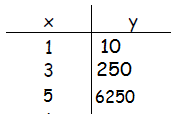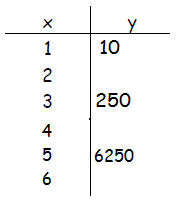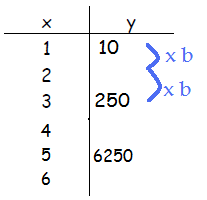Tables
| Site: | St. Louis |
| Course: | Michigan Algebra I Sept. 2012 |
| Book: | Tables |
| Printed by: | Guest user |
| Date: | Saturday, November 29, 2025, 9:29 PM |
Description
Tables
Exponential Functions
In the table below notice that as the x-values increase by 1, the y-values double. In other words, to get from one y-value to the next, multiply by 2, therefore the common ratio is 2.
![]()
To find the equation that represents this table of values, substitute any ordered pair from the table into the equation, and solve for a.

So the model for this data is: ![]()
Example 1

Step 1. Find the common ratio for the table.


Step 3. Use the values of a and b to write an equation.
Example 2

Step 1. Fill in the table to include the missing values for x.

Example 2 Continued

Since each value of y is moved 2 units for x, ![]() , or b2 is required to move between two points. To determine the b -value, set up an equation and solve.
, or b2 is required to move between two points. To determine the b -value, set up an equation and solve.
10•b2 = 250
b2 = 25
b = 5
Step 3. Use an ordered pair to solve for the value of a.
For this example, use the point (1, 10)

Step 4. Use the values of a and b to write an equation.
Video Lesson
Modeling Exponential Functions #1
Guided Practice
Guided Practice
Practice
Light Intensity Worksheet
Answer Keys
Light Intensity Answer Key
Sources
Castellon, Carol. "Math 117 Lecture 9 notes."
http://www.math.uiuc.edu/~castelln/M117/lecture9_math117.pdf (accessed September 13, 2010).
Embracing Mathematics, Assessment & Technology in High Schools; A Michigan Mathematics & Science Partnership Grant Project
Holt, Rinehart, & Winston. "Exonential and Logarithmic Functions."
http://my.hrw.com/math06_07/nsmedia/homework_help/alg2/alg2_ch07_08_homeworkhelp.html (accessed September 13, 2010).